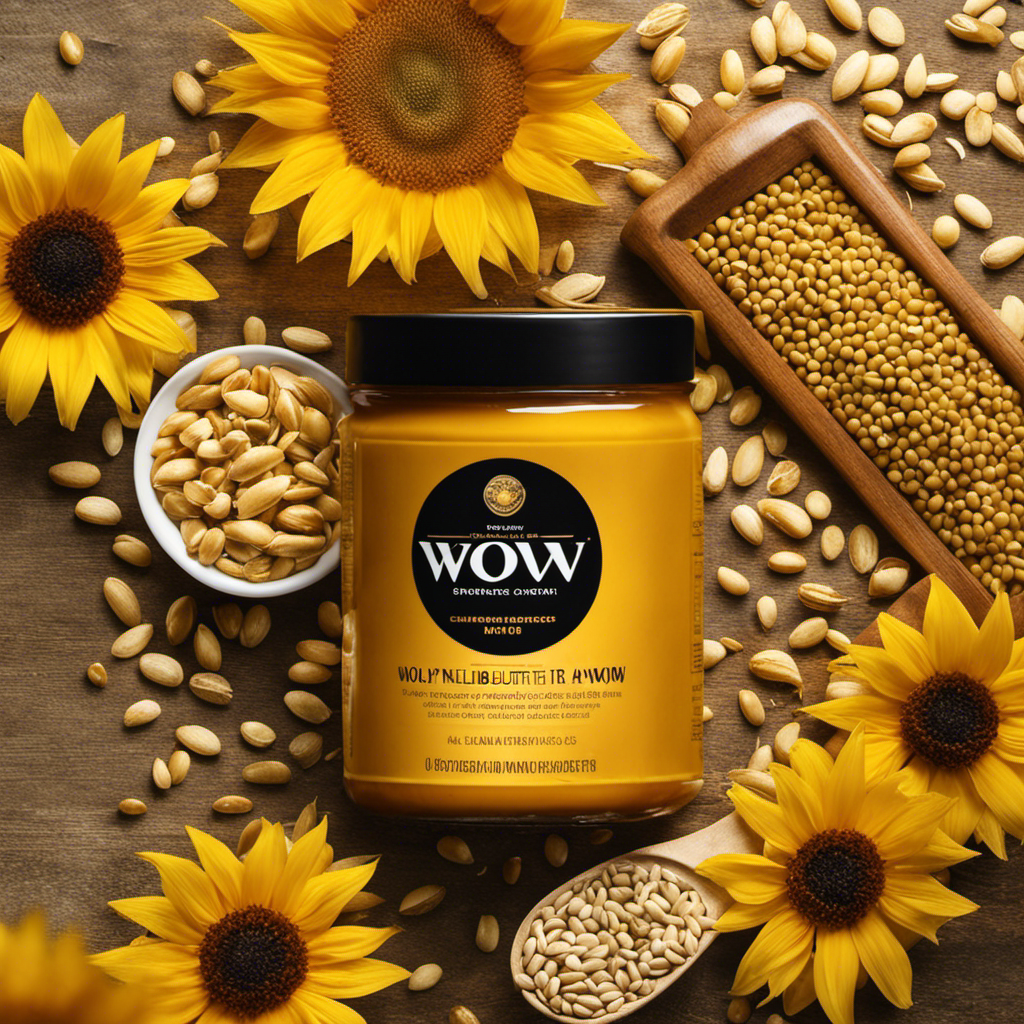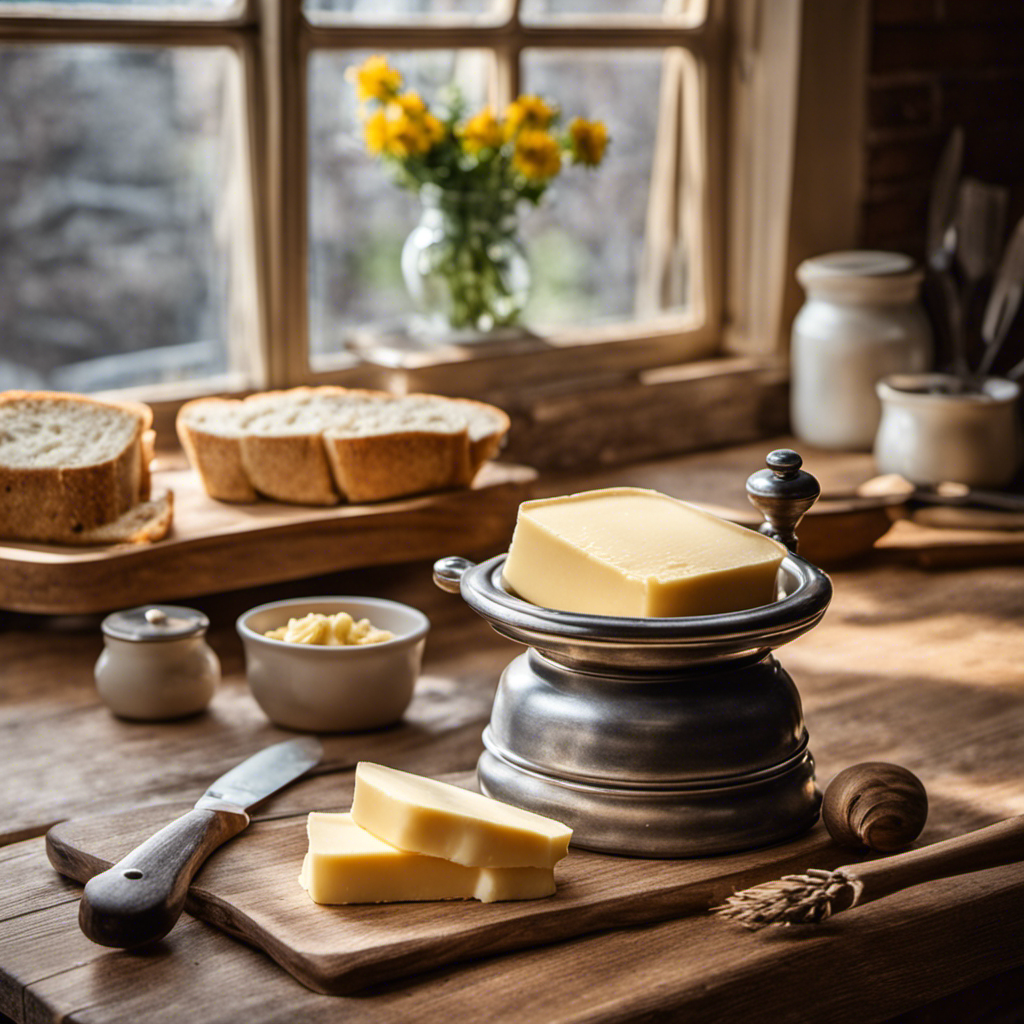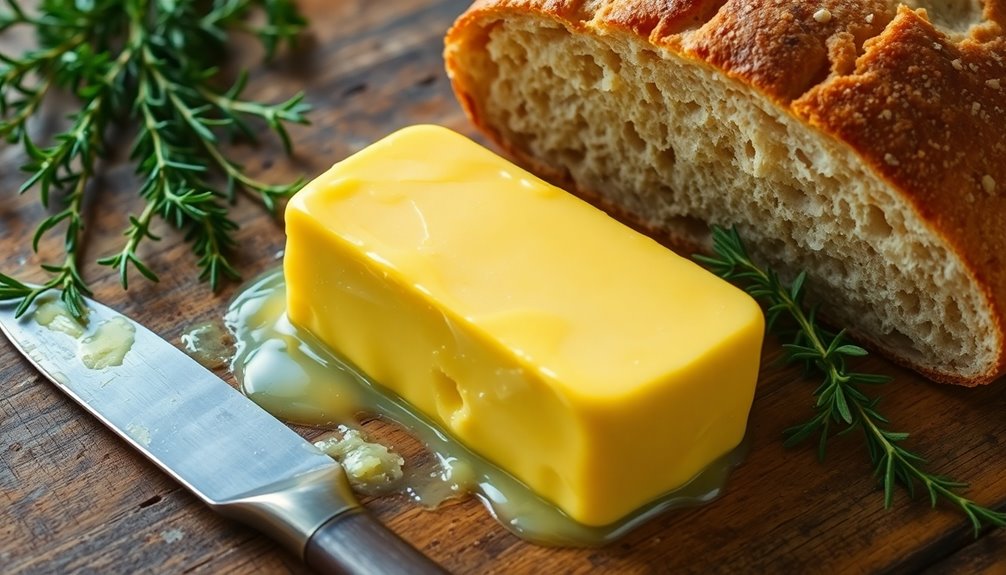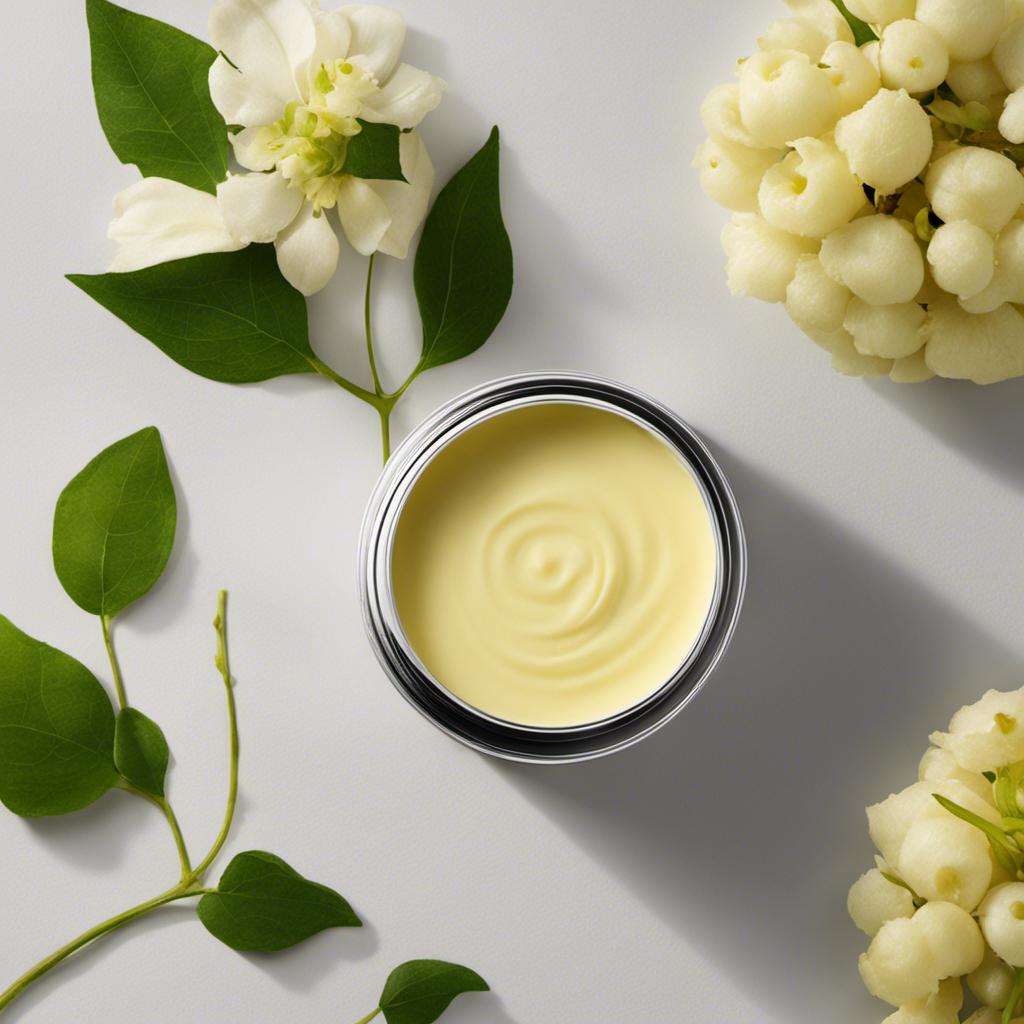I get what you’re saying: whipped butter? Isn’t regular butter already creamy and simple to spread? But trust me, once you try whipped butter, you won’t go back.
This heavenly concoction takes the velvety smoothness of regular butter and elevates it to a whole new level. In this article, I’ll take you on a journey to discover the origins, process, benefits, and even some delectable recipes using whipped butter.
Get ready to indulge in buttery bliss like never before!
Key Takeaways
- Whipped butter was introduced in the early 20th century as a spreadable alternative to traditional butter and gained popularity for its light and fluffy texture.
- Whipped butter is a healthier alternative to margarine, containing fewer additives, preservatives, and trans fats.
- The process of making whipped butter involves softening regular butter at room temperature and beating it vigorously to incorporate air, resulting in a light and fluffy texture.
- Whipped butter is easier to spread and comes in a wide array of flavors, adding a burst of flavor to dishes and elevating any meal or snack.
The Origins of Whipped Butter
The origins of whipped butter can be traced back to the early 20th century. Whipped butter was first introduced as a way to make butter more spreadable and easier to use. It quickly gained popularity due to its light and fluffy texture, which made it perfect for spreading on bread or toast.
The history of whipped butter is closely tied to the cultural significance of butter itself. Butter has long been a staple in many cuisines around the world, and the invention of whipped butter only made it more versatile and accessible.
Today, whipped butter is not only enjoyed for its convenience, but also for its ability to enhance the flavors of dishes and add a creamy richness to baked goods.
The Process of Making Whipped Butter
To make whipped butter, you’ll need to start by softening the regular butter.
The process of making this delicious spread is quite simple yet transformative. First, take the desired amount of butter and let it sit at room temperature until it becomes soft and pliable.
Then, transfer it to a mixing bowl and use an electric mixer or a whisk to beat the butter vigorously. This incorporates air into the butter, creating a light and fluffy texture.
The origins of whipped butter trace back to the early 20th century when it was first introduced as a spreadable alternative to traditional butter. Today, whipped butter is loved for its smooth consistency and ability to easily melt onto warm bread or toast.
The Benefits of Whipped Butter
When it comes to finding a healthier alternative to margarine, whipped butter is an excellent choice.
Not only does it offer a delicious taste, but it also contains fewer additives and preservatives.
Plus, one of the major advantages of whipped butter is its smooth and creamy texture, making it incredibly easy to spread on bread or toast.
Healthier Alternative to Margarine
Whipped butter is a healthier alternative to margarine because it contains less trans fats. It’s a creamy and spreadable delight that not only enhances the flavor of your favorite dishes but also provides various health benefits.
Unlike margarine, which is made from vegetable oils and often contains harmful trans fats, whipped butter is a natural product made from pure cream. This means that it retains its natural nutrients, such as vitamins A, E, and K. These vitamins are essential for maintaining healthy skin, supporting your immune system, and promoting good eye health.
Furthermore, whipped butter is a great source of healthy fats, which are necessary for the absorption of fat-soluble vitamins and for providing long-lasting energy.
When cooking with whipped butter, remember to use it in moderation as it can add richness and flavor to your dishes. Its creamy texture makes it perfect for spreading on toast, muffins, or pancakes.
Easier to Spread
Using whipped butter as a spread is easier because of its creamy texture. When I take a slice of warm toast and spread on some whipped butter, it effortlessly glides across the bread, melting into it in a way that regular butter just can’t match.
This ease of spreading is one of the key benefits of using whipped butter. Whether it’s on toast, bagels, or muffins, the smooth consistency of whipped butter makes it a breeze to spread evenly. No more tearing the bread or struggling to get a thin layer of butter.
With whipped butter, I can enjoy the perfect ratio of butter to bread, resulting in a delicious and satisfying bite every time.
Different Varieties of Whipped Butter
When it comes to whipped butter, there is a wide array of flavors to choose from that can elevate any meal or snack. From classic salted and unsalted varieties to unique options like garlic and herb or honey cinnamon, there is a flavor to suit every taste preference.
Not only does whipped butter add a burst of flavor to dishes, but it also offers numerous nutritional benefits. It is a good source of healthy fats and essential vitamins.
Flavors Available in Whipped Butter
You can find a variety of flavors available in whipped butter, such as garlic and herb or honey cinnamon. These delicious flavors add a burst of taste to your dishes and can elevate any meal. Here are some popular flavors that you can explore:
-
Garlic and Herb: This whipped butter is infused with the aromatic flavors of garlic and a blend of herbs. It’s perfect for spreading on warm bread or adding to mashed potatoes for a savory twist.
-
Honey Cinnamon: Indulge your sweet tooth with this delightful combination of honey and cinnamon. Spread it on pancakes, toast, or use it as a topping for baked goods. The sweet and spicy flavors will make your taste buds dance.
-
Maple Pecan: This whipped butter combines the rich flavors of maple syrup and crunchy pecans. It’s a wonderful addition to waffles, oatmeal, or even as a glaze for roasted vegetables.
With these flavored whipped butter options, you can experiment and create unique recipes that will impress your family and friends. So go ahead and indulge in the creamy goodness of whipped butter with a burst of flavor!
Uses for Whipped Butter
One way to enhance your dishes is by incorporating flavored whipped butter into your recipes. It not only adds a burst of flavor but also provides several health benefits.
Whipped butter is lighter and fluffier than regular butter, making it easier to spread and incorporate into your dishes. The process of whipping butter incorporates air, which creates a creamy and smooth texture. This makes it ideal for spreading on bread, melting over vegetables, or using as a base for sauces and dressings.
Whipped butter also has lower fat content compared to regular butter, which can be beneficial for those watching their calorie intake. Additionally, it contains essential vitamins and minerals, such as Vitamin A and Vitamin D.
Nutritional Benefits of Whipped Butter
To enhance your nutritional intake, consider incorporating the lighter and fluffier option of flavored whipped butter into your daily meals. Whipped butter not only adds a burst of flavor to your dishes but also offers various health benefits.
Here are some flavor variations of whipped butter to spice up your meals:
- Garlic and herb: Perfect for spreading on warm bread or tossing with roasted vegetables.
- Honey and cinnamon: A delightful addition to pancakes or waffles for a touch of sweetness.
- Lemon and dill: Add a refreshing twist to grilled fish or steamed vegetables.
Whipped butter can be used in various cooking techniques, such as:
- Baking: Use it as a substitute for regular butter in cakes, cookies, and pastries to create a lighter texture.
- Sauteing: Whip butter with your favorite herbs and spices to add flavor to sautéed vegetables or meats.
- Grilling: Slather whipped butter on corn on the cob or grilled meats for a rich, delicious taste.
Incorporating flavored whipped butter into your meals not only elevates the taste but also provides you with essential nutrients and healthy fats. So why not give it a try and enjoy the benefits it brings to your table?
Whipped Butter Vs. Regular Butter: a Comparison
Whipped butter has a lighter texture compared to regular butter. It is made by aerating butter, which adds air and gives it a fluffy and spreadable consistency. This process also changes the taste of the butter, making it slightly sweeter and more delicate. Whipped butter is perfect for spreading on toast, muffins, or pancakes. It melts quickly and evenly, creating a smooth and creamy experience. Regular butter, on the other hand, has a denser texture and a rich, buttery flavor. It is often used in baking and cooking, where its solid form is necessary for certain recipes. Below is a table that highlights the taste and texture differences between whipped butter and regular butter:
| Whipped Butter | Regular Butter | |
|---|---|---|
| Taste | Slightly sweet | Rich and buttery |
| Texture | Light and fluffy | Dense and solid |
Whether you prefer the lightness of whipped butter or the richness of regular butter, both options have their own unique qualities that can enhance your culinary creations.
Cooking and Baking With Whipped Butter
When it comes to cooking and baking, whipped butter is a versatile ingredient that can be used in various ways. Its light and airy texture makes it easy to incorporate into recipes, and it can enhance the flavor and texture of your dishes. Here are some cooking techniques to make the most out of whipped butter:
- Use it as a substitute for regular butter in recipes that require creaming, such as cakes and cookies.
- Melt it and use it as a flavorful drizzle over grilled vegetables or baked potatoes.
- Spread it on bread or rolls before toasting for a deliciously crispy and buttery crust.
Not only does whipped butter add a rich and creamy taste to your dishes, but it also offers some nutritional value. It contains less saturated fat than regular butter and is a good source of Vitamin A and Vitamin E.
Now that we know how to incorporate whipped butter into our cooking, let’s explore some creative spreading and topping ideas for this delicious ingredient.
Spreading and Topping Ideas for Whipped Butter
When it comes to whipped butter, the possibilities are endless. From unique flavor combinations that elevate your taste buds, to creative uses that go beyond simply spreading it on toast, there is so much to explore.
Not only does whipped butter add a delicious touch to your meals, but it also offers health benefits, making it a versatile and nutritious addition to your kitchen.
Flavor Combinations for Whipped Butter
Adding honey to your butter creates a sweet and creamy flavor combination. It’s a simple and delicious way to elevate your butter and add a touch of sweetness to your dishes.
Here are some flavor pairing ideas and whipped butter recipe variations to inspire your culinary adventures:
- Cinnamon Sugar: Mix in a sprinkle of cinnamon and a spoonful of sugar for a warm and comforting flavor.
- Herb and Garlic: Add minced garlic and chopped herbs like parsley, thyme, or rosemary for a savory twist.
- Citrus Zest: Grate some lemon or orange zest into your whipped butter for a refreshing and tangy flavor.
These flavor combinations can be used in a variety of dishes, from spreading on toast to topping grilled vegetables or baked potatoes.
Now, let’s explore some creative uses for whipped butter that will take your meals to the next level.
Creative Uses for Whipped Butter
After exploring all the delicious flavor combinations for whipped butter, I can’t wait to share some creative uses for this versatile spread.
Whipped butter is not just meant for toast or pancakes; it can elevate your cooking and baking to new heights. One of my favorite uses is adding a dollop of flavored whipped butter to a warm bowl of oatmeal for a burst of creamy goodness.
You can also melt it over steamed vegetables or grilled meats for an extra burst of flavor. And don’t forget about the sweet side! Whipped butter can be incorporated into frostings, glazes, and even homemade ice cream for a rich and indulgent treat.
The possibilities are endless when it comes to creative uses for whipped butter, so go ahead and let your culinary imagination run wild!
Health Benefits of Whipped Butter
To get the most out of your spread, you’ll want to know about the health benefits of using whipped butter. Whipped butter not only adds a creamy touch to your meals but also provides several nutritional advantages.
Here are some health benefits of using whipped butter:
-
Reduced saturated fat content: Whipped butter typically contains less saturated fat than regular butter, making it a healthier option for those watching their fat intake.
-
Increased spreadability: Whipped butter is softer and easier to spread, allowing you to use less butter overall and reduce calorie consumption.
-
Enhanced flavor: Whipping butter incorporates more air into the product, resulting in a lighter texture and a more enjoyable taste experience.
Whipped Butter as a Dairy-Free Alternative
If you’re looking for a dairy-free alternative, whipped butter can be a great option for you. Whipped butter is a creamy and spreadable substitute for regular butter that is made without any dairy products. It is perfect for those who are lactose intolerant or follow a vegan lifestyle. Whipped butter is made by whipping vegetable oil or plant-based oils with water, creating a light and fluffy texture. It can be used in a variety of ways, from spreading on toast to baking delicious pastries.
Here are three whipped butter recipes that you can try at home:
| Recipe | Ingredients | Instructions |
|---|---|---|
| Whipped Coconut Butter | 1 cup coconut oil, 1/4 cup almond milk, 1 tsp vanilla extract | 1. Melt the coconut oil and let it cool. 2. In a mixing bowl, combine the coconut oil, almond milk, and vanilla extract. 3. Use an electric mixer to whip the mixture until light and fluffy. |
| Whipped Avocado Butter | 2 ripe avocados, 2 tbsp lemon juice, 1/4 cup olive oil | 1. Scoop out the flesh of the avocados and place them in a mixing bowl. 2. Add the lemon juice and olive oil. 3. Use a fork or a blender to blend the ingredients until smooth and creamy. |
| Whipped Soy Butter | 1 cup soybean oil, 1/4 cup water, 1 tsp salt | 1. In a mixing bowl, combine the soybean oil, water, and salt. 2. Use an electric mixer to whip the mixture until it becomes light and airy. 3. Transfer the whipped soy butter to a container and refrigerate until solid. |
With these dairy-free whipped butter recipes, you can enjoy the creamy and rich taste of butter without any dairy products. So go ahead and give them a try!
Storing and Shelf Life of Whipped Butter
When storing your homemade dairy-free alternative, make sure to keep it in an airtight container in the refrigerator to maintain its freshness and extend its shelf life.
Proper storage methods are crucial for preserving the taste and texture of whipped butter. Here are some storing tips to help you keep your whipped butter fresh and prevent spoilage:
-
Use an airtight container: This will protect the whipped butter from air and moisture, which can cause it to spoil faster.
-
Follow refrigeration guidelines: Whipped butter should always be stored in the refrigerator to maintain its freshness. It is important to keep it at a consistent temperature to prevent any bacterial growth.
-
Check the best before dates: Even though whipped butter can last for a few weeks in the refrigerator, it is always a good idea to check the best before dates to ensure its quality.
By following these simple storage tips and guidelines, you can extend the shelf life of your whipped butter and enjoy its creamy goodness for longer.
And remember, if you have excess whipped butter, you can also freeze it for future use.
Frequently Asked Questions About Whipped Butter
Remember to always store your homemade dairy-free alternative in an airtight container in the refrigerator to maintain its freshness and extend its shelf life.
Now, let’s address some frequently asked questions about whipped butter.
Whipped butter is a lighter and fluffier version of regular butter. It is made by incorporating air into the butter, giving it a creamy and spreadable texture. The main difference between whipped butter and regular butter is the fat content. Whipped butter typically has a lower fat content, making it a healthier option.
In terms of nutritional information, whipped butter generally contains fewer calories and less saturated fat than regular butter. Additionally, it often has a higher water content, which can help to make it easier to spread.
Some benefits of whipped butter include its versatility in cooking and baking, as well as its ability to enhance the flavor of dishes without overwhelming them.
Overall, whipped butter is a delicious and healthier alternative to regular butter.
Whipped Butter Recipes and Ideas
Now let’s explore some tasty recipes and creative ideas for using this fluffy spread.
Whipped butter is not just for spreading on toast or muffins; it can add a delightful twist to both sweet and savory dishes. Here are a few ideas to get your culinary creativity flowing:
-
Whipped Butter in Desserts: Add a dollop of whipped butter to your favorite cookie or cake batter for a lighter and fluffier texture. It can also be used as a creamy topping for pancakes, waffles, or even a warm slice of pie.
-
Whipped Butter in Savory Dishes: Whip up some flavored whipped butter, such as garlic or herb-infused, and use it to add richness and depth to mashed potatoes, roasted vegetables, or grilled meats. It can also be melted and drizzled over a juicy steak or tossed with pasta for a creamy sauce.
Frequently Asked Questions
Can Whipped Butter Be Used as a Substitute for Regular Butter in Recipes?
Yes, whipped butter can be used as a substitute for regular butter in recipes. It has a lighter texture and spreads easily. Whipped butter also adds a creamy richness to dishes, making it a versatile choice for cooking and baking.
How Is Whipped Butter Different From Traditional Butter in Terms of Texture and Taste?
Whipped butter is a creamy and spreadable alternative to traditional butter. It has a light texture and a slightly sweeter taste. It’s perfect for spreading on toast or using in recipes that call for softened butter.
Is Whipped Butter Suitable for Individuals With Lactose Intolerance or Dairy Allergies?
For those with lactose intolerance or dairy allergies, whipped butter alternatives can be a great option. They provide the same creamy texture and taste without the lactose or dairy. Plus, the benefits of whipped butter in baking are endless!
Can Whipped Butter Be Frozen for Long-Term Storage?
Freezing whipped butter can be a convenient way to extend its shelf life. However, it can affect the texture and taste. To properly store whipped butter in the freezer, ensure it’s tightly sealed and use it within a few months for best results.
Is Whipped Butter More or Less Healthy Than Regular Butter?
Is whipped butter a healthier choice for weight loss? Whipped butter is often believed to be a healthier option due to its lower calorie and fat content compared to regular butter. However, it’s important to consider the overall nutritional comparison before making a decision.
Conclusion
After learning about the origins, process, benefits, and varieties of whipped butter, it becomes clear that this creamy delight is a must-have in every kitchen.
Its light and fluffy texture, combined with its rich and flavorful taste, make it a perfect addition to any meal.
Just like a warm hug on a cold winter day, whipped butter adds a touch of comfort and indulgence to every bite.
So go ahead, whip up some magic in your kitchen and let the creamy goodness melt your heart.










